Last Updated on January 8, 2024 by Greg Gillson
I’ve put this resource together for you to answer your question: What birds are in my backyard in Missouri?
This article lists and discusses the identification of the most common birds in your backyard. The birds chosen in this article are compiled from actual data from the citizen science program eBird. Thus, it is more accurate than some other similar articles you may find on the web. I provide pictures of each bird species mentioned and I’ll tell how to attract them to your backyard.
These are the most common backyard birds in Missouri:
- Northern Cardinal
- Blue Jay
- Mourning Dove
- American Robin
- Red-bellied Woodpecker
- Tufted Titmouse
- Downy Woodpecker
- American Goldfinch
- American Crow
- Carolina Wren
- European Starling
- White-breasted Nuthatch
- Dark-eyed Junco
- Red-winged Blackbird
- House Sparrow
- Eastern Bluebird
- White-throated Sparrow
- House Finch
- Black-capped Chickadee
- Carolina Chickadee
- Northern Flicker
- Common Grackle
- Brown-headed Cowbird
- Indigo Bunting
- Song Sparrow
- Eastern Phoebe
- Barn Swallow
- Eastern Wood-Pewee
- Ruby-throated Hummingbird
- Eastern Kingbird
- Blue-gray Gnatcatcher
- Chipping Sparrow
Missouri Birds and Birding in Missouri State
eBird lists over 415 types of birds as occurring in the state of Missouri.
The most common bird in Missouri: the most frequently seen bird in the state is Northern Cardinal. It is reported on 63% of bird watching lists.
If you are serious about knowing the birds native to Missouri, then check out eBird for Missouri. It has recent sightings and photos, illustrated checklists with weekly abundance bar charts for state, counties, and individual hotspots of the best birding locations.
If you want to know about other people interested in birds in your area, join a local bird group. The American Birding Association maintains a list of bird watching clubs for each state.
Missouri Bird Identification
This section is the species accounts. These are designed to help you to recognize birds you see in your backyard. I have used eBird to select the birds that are most common. “Common” means the birds seen most often throughout the year, not necessarily the most numerous.
Each species account starts with a photograph. In the identification section I am using size and shape and bill type before considering the color or patterns on the birds. I find these more reliable when trying to identify an unknown bird. Pay attention to body and tail shape and especially bill shape of birds you see, not just plumage color.
In the section on bird feeders and foods I tell how to attract each species. Not all types of backyard birds will come to feeders. But all backyard birds can be attracted with water. So don’t forget to add a birdbath to your bird feeding station.
Do you live in Northern Missouri? Southern Missouri? Eastern Missouri? Central Missouri? In the Ozarks? In southeast or southwest Missouri?
To appear in this article, most birds are widely distributed throughout the state and are often year-round residents. However, for those birds that are more localized in place or time, I list the general region and seasonality. Please see the section following these species accounts for the lists of common species by season.
Even if a species is found in a general area, they occur only in the habitat they prefer. So, the exact habitat of your neighborhood is important for the presence of absence of certain kinds of birds.
1. Northern Cardinal (Cardinalis cardinalis)
This is one of the most common and popular backyard birds in the eastern half of the United States.
 |
| Northern Cardinal. GeorgeB2. Pixaby |
Range in Missouri: Northern Cardinals are year-round residents throughout Missouri.
Identification:
Size: Cardinals are a bit smaller than American Robins, about the same size as Red-winged Blackbirds.
Shape: Plump body with fairly long full tail. Wispy crest.
Bill: Short, heavy, conical, pink.
Color: That bright red color is matched by few other birds. Black face. The female is grayer, but with hints of red in wings and tail, and has a crest, too.
Habitat, range & behavior: Cardinals are year-round residents in shrubby woodland edges.
From the eastern United States to Texas and Arizona south into Mexico.
That large conical bill is made for chewing seeds. Watch them crack open sunflower seeds, spit out the hulls, and pluck the kernel with their tongues!
Food and feeder preference: Black oil sunflower seeds. Many types of seeds, berries, nuts in larger hopper or tray feeders.
You may like my in-depth article on attracting Northern Cardinals.
2. Blue Jay (Cyanocitta cristata)
A common and well-known bird in the eastern half of the United States.
 |
| Blue Jay. skeeze. Pixabay |
Range in Missouri: Blue Jays are year-round residents throughout Missouri.
Identification:
Size: About that of American Robin.
Shape: Fluffy, large crested head, ample tail. Large strong legs.
Bill: Black, long and stout.
Color: Blue above, white below. Black neck collar. White patches in wing.
Habitat, range & behavior: Woodlands and towns.
In the eastern half of the United States. In summer into southern Canada.
Bold and brash. May bully smaller birds. Jays gulp lots of seeds or other food at once, storing it in their crop. Then they fly off and bury food items in a hidden cache.
Food and feeder preference: Omnivorous. They can quickly empty your feeder! Because they are also aggressive toward other feeder birds, some people put mesh cages around smaller bird feeders. Small birds can go through, squirrels and larger “pest” birds are prevented entry. Some people feed jays peanuts, perhaps away from the seed feeders.
3. Mourning Dove (Zenaida macroura)
Mourning Doves are the most widespread and most frequent backyard bird in the Lower 48 states of the United States.
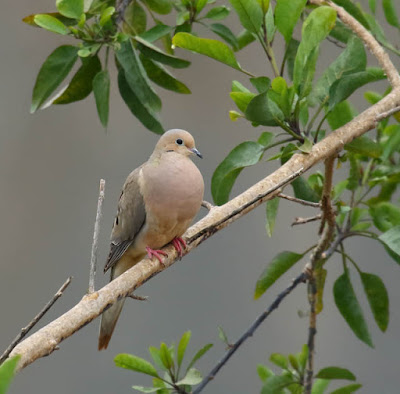 |
| Mourning Dove. Greg Gillson |
Range in Missouri: Mourning Doves are year-round residents throughout Missouri.
Identification: This is a key species for comparing with an unknown bird.
Size: About 12 inches long from bill tip to tail tip. About same size as Northern Flicker. Larger than American Robin. Slightly smaller than domestic city pigeon.
Shape: Very plump with a small round head. Tail is long and pointed. Legs are short.
Bill: Small and rather slender.
Color: Pale brown-pink body, darker wings and tail. White edges on side of tail.
Habitat, range & behavior: Semi-open areas such as urban areas, farmlands, woods.
It is a resident across the lower-48 states and Mexico, with some movement out of northern areas in winter.
Often seen perched on wires, fences. Their mournful cooing is a familiar spring birdsong.
Food and feeder preference: Mourning Doves eat seeds almost exclusively. Attract with black oil sunflower seeds on a large sturdy tray feeder or on the ground.
4. American Robin (Turdus migratorius)
This familiar bird is a resident in the northern half of the United States and a winter visitor in the southern half.
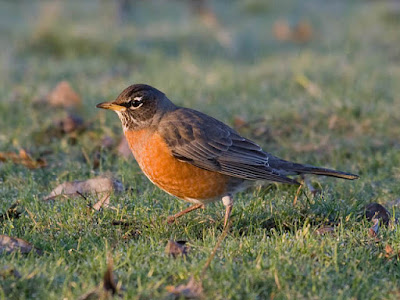 |
| American Robin. Greg Gillson |
Range in Missouri: American Robins are year-round residents throughout Missouri.
Identification: This is a key species for comparing with an unknown bird.
Size: 10 inches long from bill tip to tail tip. About the same size as a Blue Jay or one of the Scrub-Jays. Larger than Red-winged Blackbird. Smaller than a Mourning Dove.
Shape: Very plump with a fairly long tail.
Bill: Straight and fairly slender, curved at the tip.
Color: Gray-brown upperparts, rusty orange breast.
Habitat, range & behavior: Open woodlands, farmlands, urban parks and lawns.
Migratory, breeds north across Alaska and Canada. Resident in most of the United States (lower 48). Winters in the United States, Mexico, to central America.
Hops on your lawn turning head this way and that looking for food. Their caroling song is one of the early signs of spring in the north.
Food and feeder preference: Worms and other invertebrates in the lawn. May eat fruit from a tray feeder or the ground. Eat small berries from trees and bushes.
5. Red-bellied Woodpecker (Melanerpes carolinus)
This is one of the most common species in the eastern half of the United States.
 |
| Red-bellied Woodpecker. skeeze. Pixabay |
Range in Missouri: Red-bellied Woodpeckers are year-round residents throughout Missouri.
Identification:
Size: Fairly large for a backyard bird. Between a Starling and American Robin in size. Smaller than a Northern Flicker.
Shape: Stout with large head and short tail. Clings to tree trunk on strong short legs propped up with short stiff tail.
Bill: Long, chisel shaped.
Color: Pale gray body, many thin black-and-white bars across back and wings. Red nape, extending forward on crown on male.
Habitat, range & behavior: These birds are found in many woodland types, including oak, hickory and pine.
They are found from the eastern slope of the Rocky Mountains in the lower-48 states from Texas to extreme southern Canada, and eastward from Florida northward just to the southern edge of the New England states.
In typical woodpecker fashion, it hitches up the tree trunk and larger branches.
Food and feeder preference: This species eats insects and nuts. They may eat peanuts from a tray feeder and eat from a suet block.
6. Tufted Titmouse (Baeolophus bicolor)
Related to chickadees, they lack the black bib, but have a crest instead.
 |
| Tufted Titmouse. anne773. Pixabay |
Range in Missouri: Tufted Titmice are year-round residents throughout Missouri.
Identification:
Size: A small bird, but a large titmouse, this species is larger than chickadees, about the size of a junco or House Finch.
Shape: Rounded body, long full tail, big head, long legs.
Bill: Short and stout, compressed (taller than wide), black.
Color: Dark blue-gray above, pale below. Black feathers around eye accentuates its size.
Habitat, range & behavior: Lives in deciduous forests with heavy canopy, parks.
Found in eastern and southeastern United States is expanding its range north and west.
Backyard bird feeders might be helping this species expand its range northward.
Food and feeder preference: Insects and seeds. At your hopper or tray feeder they like black oil sunflower seeds and suet.
7. Downy Woodpecker (Dryobates pubescens)
This tiny woodpecker is found across the United States.
 |
| Downy Woodpecker. Greg Gillson |
Range in Missouri: Downy Woodpeckers are year-round residents throughout Missouri.
Identification:
Size: Bigger than a junco or House Finch. Smaller than a Red-winged Blackbird. About the same size as a White-crowned Sparrow, but with a much shorter tail.
Shape: Stocky with large head and short stiff tail.
Bill: Short, chisel shaped.
Color: Black-and-white striped head. Black wings with white spots. Solid white back. White under parts. Black tail with white outer tail feathers with black bars or spots. Male with small red spot at back of head.
Habitat, range & behavior: Found in small deciduous trees, willows, and even weed stocks such as teasel, especially near water.
Ranges coast-to-coast across all but northernmost parts of Canada and Alaska south to the southern US. Absent in the desert southwest.
Interestingly, I learned today that the males may more often be found in smaller plants and twigs, while females are more likely on tree trunks.
Food and feeder preference: Insects, fruits, and seeds. Gleans arthropods from the bark of trees. Attract with suet feeder. Will also eat black oil sunflower seeds.
8. American Goldfinch (Spinus tristis)
A beautiful tiny finch familiar to many in its bright yellow summer plumage. Colloquially called a “wild canary.”
 |
| American Goldfinch. Greg Gillson |
Range in Missouri: American Goldfinches are year-round residents throughout Missouri.
Identification: This is a key species for comparing with an unknown bird.
Size: Very small at about 5 inches from bill tip to tail tip. Similar in size to a chickadee. Larger than hummingbirds. Smaller than juncos and House Finches.
Shape: Tiny, somewhat plump with larger head and short tail.
Bill: Short, conical, pink.
Color: Males in summer are bright lemon yellow with black forehead and black wings and tail with white bars. White under tail coverts. Females are dull olive, wings and tail browner. Winter birds are pale grayish-yellow with tan and brown wings and tail.
Habitat, range & behavior: This species is found in weedy fields and similar clearings with thistles and similar plants.
It is found coast-to-coast throughout the year across most of the middle lower-48 states. In summer moves north to the Canada border. In the winter found south to the Mexico border.
The flight is highly undulating, rising and falling as they flap in short bursts. Besides a long, sweet lilting song, they call in flight a lilting 4-part: “potato chip!”
Food and feeder preference: Feeds on weed seeds, thistle seed. May eat black oil sunflower seeds from tube feeder. Love Nyjer seed in a feeder called a “thistle sock.”
You may like my in-depth article on attracting American Goldfinches.
9. American Crow (Corvus brachyrhynchos)
This larger all-black bird is common in cities and country. Its cawing call is familiar to most people.
 |
| American Crow. Greg Gillson |
Range in Missouri: American Crows are year-round residents throughout Missouri.
Identification: This is a key species for comparing with an unknown bird.
Size: About 17-1/2 inches long from bill tip to tail tip, though there is much size variation throughout its range. Larger than blackbirds and grackles. Smaller than ravens.
Shape: Thick neck, large head, rather short square-ended tail. Longer legs. In flight has rounded wing tips with each primary feather separated from others forming “fingers.”
Bill: As long as head, thick, black.
Color: Glossy black throughout.
Habitat, range & behavior: They prefer open areas with trees, fields, farms, cities.
They are common across most of the United States lower-48, except in the desert southwest. They move into southern Canada in summer.
They gather in evening communal roosts in large flocks that may number into the thousands and then move out at dawn into the surrounding area.
Food and feeder preference: Omnivorous, they feed on large insects, grain, small mammals, carrion. You probably don’t want these large entirely black birds in your backyard feeders. So don’t feed table scraps to birds.
10. Carolina Wren (Thryothorus ludovicianus)
This is a fairly common backyard bird in the much of the eastern United States.
 |
| Carolina Wren. theSOARnet. Pixabay |
Range in Missouri: Carolina Wrens are year-round residents throughout Missouri.
Identification:
Size: A smaller bird, between the size of American Goldfinch and House Finch.
Shape: Round body, short neck, flat head, long tail flipped about actively.
Bill: Fairly long, thin, pointed and slightly curved.
Color: Upper parts rusty brown with black bars on the wings and tail. A white eyebrow line and buff under parts.
Habitat, range & behavior: Shrubby thickets and brushy suburban yards.
It is found in the southeastern United States and Yucatan. Northern parts of range expand and contract depending upon harshness of winters.
Males sing throughout the year and are very loud for their size.
Food and feeder preference: Feed mostly on insects and spiders. They will feed on suet.
11. European Starling (Sturnus vulgaris)
Introduced to North America in the late 1800’s, they crossed the continent, often to the detriment of native cavity-nesting birds. The prime example of an invasive species.
 |
| European Starling. Greg Gillson |
Range in Missouri: European Starlings are year-round residents throughout Missouri.
Identification: This is a key species for comparing with an unknown bird.
Size: 8-1/2 inches from bill tip to tail tip. About the size of a Red-winged Blackbird. Smaller than an American Robin. Larger than a White-crowned Sparrow or Spotted/Eastern towhee.
Shape: Stocky with large head, short square-ended tail. Longer legs.
Bill: As long as head. Sharp pointed. Yellow in spring, otherwise dark.
Color: They are grayish brown much of the year, with glossy iridescence and white spotting during the spring.
Habitat, range & behavior: Lowland birds that need trees large enough for nest cavities but plenty of open area for feeding. They are most abundant in urban and suburban areas where they find food and artificial nest cavities.
Resident from coast-to-coast from southern Canada to northern Mexico. In summer north across Canada and Alaska. Native range is Europe to Pakistan, north Africa.
Often viewed as a pest, starlings often bully other backyard birds, taking over bird feeders, and stealing nest cavities from smaller native birds. In winter they can form into flocks of tens of thousands.
Food and feeder preference: Primarily insects when available, often feeding on the ground. Discourage them from your backyard hopper and tray feeders by never feeding birds table scraps (including bread or meat). They have weak feet and do not perch well on tube feeders. A cage mesh around smaller hopper feeders may keep them out.
12. White-breasted Nuthatch (Sitta carolinensis)
A favorite feeder bird for many for its active antics and fearlessness. Though a small bird it is the largest nuthatch in North America.
 |
| White-breasted Nuthatch. Greg Gillson |
Range in Missouri: White-breasted Nuthatches are year-round residents throughout Missouri.
Identification:
Size: About chickadee-sized in length. Smaller than a junco or House Finch.
Shape: Appears large-headed, neckless, very short tailed. Short legs.
Bill: Nearly as long as head, straight, thin.
Color: Blue-gray above, white below. Black cap, wing tips, tail. Rusty feathers under tail.
Habitat, range & behavior: Common in oak and oak-pine woodlands, wooded towns.
Found across the United States, southern Canada, mountains of central Mexico. Absent from treeless grasslands, deserts in the west.
Crawls over tree branches and head-first down tree trunks searching for insects.
Food and feeder preference: Insects, seeds, acorns and other nuts. Love black oil sunflower seeds feeding on hopper and tray feeders. Suet blocks.
13. Dark-eyed Junco (Junco hyemalis)
Colloquially called “snowbirds,” they often arrive in backyards in winter from nearby mountain forests or more northern climes.
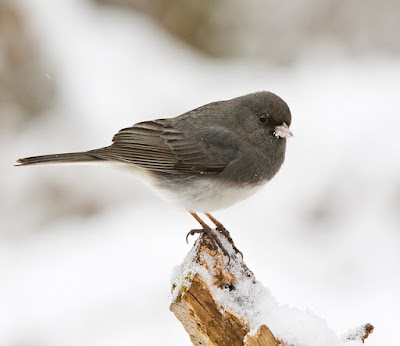 |
| Dark-eyed Junco. skeeze. Pixabay |
Range in Missouri: Dark-eyed Juncos are winter visitors throughout Missouri.
Identification:
Size: Small birds about the size of a House Finch.
Shape: Round body, short neck, round head, fairly long square-ended tail.
Bill: Short, pointed, conical, pink.
Color: Eastern birds are a darker all-gray with white belly. Western birds have jet black hood over the head, brown back, and pink sides.
Habitat, range & behavior: Breed in coniferous forests. Winters widely. Avoids heavy brush, preferring widely spaced bushes.
Breeds across most of Canada, Alaska, and the western half of the United States. Winters from southern Canada and all of the lower 48-states to extreme northern Mexico.
Spend much of their time hopping and feeding on the ground.
Food and feeder preference: Eats mostly seeds, also insects in summer. Readily feed at backyard feeders on mixed seeds on hopper or tray feeders and ground.
You may like my in-depth article on attracting Dark-eyed Juncos.
14. Red-winged Blackbird (Agelaius phoeniceus)
These noisy flocking birds are most often found in marshes. But in winter they are found in backyards.
 |
| Male Red-winged Blackbird. Greg Gillson. |
 |
| Female Red-winged Blackbird. Greg Gillson. |
Range in Missouri: Red-winged Blackbirds are year-round residents throughout Missouri.
Identification: This is a key species for comparing with an unknown bird.
Size: About 8-3/4 inches long from bill tip to tail tip. About the size of a Northern Cardinal. Smaller than an American Robin.
Shape: Pot-bellied with a longer bill and flat forehead. Tail average.
Bill: Long and sharp pointed.
Color: Males are black with red and yellow shoulder patch. Females are streaked brown and rusty (sparrow-like but pointed bill and flat forehead).
Habitat, range, and behavior: Cattail marshes and wetlands are their summer habitat. In winter they feed in grain fields.
They breed across most of the North American continent. In winter they withdraw from most of Alaska and Canada.
They are found in colonies in summer and large flocks in winter.
Food and feeder preference: They eat insects in summer. In winter they eat grain and seeds. They visit feeders, more often in large winter flocks, and eat most seeds and suet.
15. House Sparrow (Passer domesticus)
Like the starling, this is another bird introduced from Europe in the 1800’s. This sparrow is commonly found in cities and farmlands. It is considered a pest in most areas where it has been introduced.
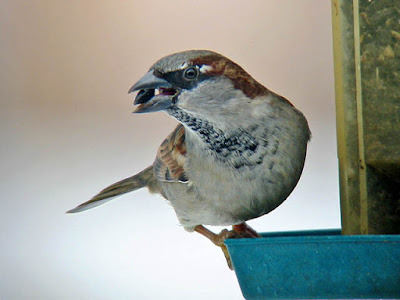 |
| House Sparrow. Greg Gillson |
Range in Missouri: House Sparrows are year-round residents throughout Missouri.
Identification:
Size: The size of a House Finch or Dark-eyed Junco.
Shape: Chunkier than native North American sparrows with large head, barrel chest, short neck, medium tail, short legs.
Bill: Short, conical.
Color: Males are brown and gray with a black mask. Females lack the black and are tan and brown with a pale line back from the eye.
Habitat, range & behavior: Cities and farms.
Range in North American from southern Canada through Central America. In summer northward through Canada to southern Alaska. Originated in Middle East and spread to most of Europe and Asia. Introduced in South America, Africa, Australia–nearly anywhere there are people and cities.
They tend to be messy… and have a good appetite and may occur in large noisy chirping flocks. They are aggressive toward other feeder birds.
Food and feeder preference: They eat grain, seed, and insects. To discourage them from your hopper and tray feeders do not feed birds human food scraps. They have a bit of difficulty eating from tube feeders.
16. Eastern Bluebird (Sialia sialis)
A beloved bird of open fields with trees and fence lines for perching.
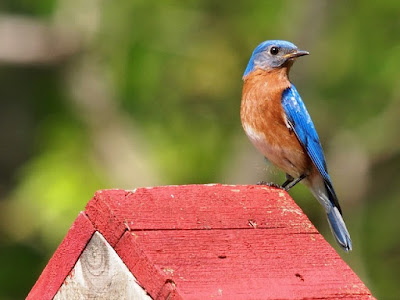 |
| Eastern Bluebird. skeeze. Pixabay |
Range in Missouri: Eastern Bluebirds are year-round residents in southern Missouri, summer residents only in central and northern Missouri.
Identification:
Size: Larger than House Finches. Much smaller than starlings. About length of White-crowned Sparrow but differently proportioned.
Shape: Chunky, large head, short tail.
Bill: Straight, fairly slender, curved at tip.
Color: Males are brilliant blue above (including wings and tail), rusty orange below with white belly and under tail. Females are often much paler, almost grayish.
Habitat, range & behavior: Found in pasture, fields, golf courses, open woodland edges.
They are resident in most of eastern US, highlands of Middle America. In summer reach northernmost eastern US and southernmost eastern Canada, withdrawing somewhat in winter.
They readily use nest boxes, but the entrance hole must be smaller than the head of a starling, and without a perch.
Food and feeder preference: They eat flying insects primarily, but also other invertebrates and berries. They will eat mealworms at your feeder and frequent birdbaths.
17. White-throated Sparrow (Zonotrichia albicollis)
A fairly common bird of northern forests that visits backyards across much of the US.
 |
| White-throated Sparrow. Greg Gillson |
Range in Missouri: White-throated Sparrows are winter visitors throughout Missouri.
Identification:
Size: Similar in size to White-crowned Sparrow. Bigger than a House Finch; smaller than a starling.
Shape: Longer body. Round head on short neck. Long tail with notched tip.
Bill: Short. conical.
Color: Striped tan and brown above, pale gray below. White-striped form with black and white head stripes. Tan-striped form with tan and brown striped head. First year birds are similar to tan-stiped adults, but streakier overall. Yellow spot between eyebrow and bill. White throat strongly offset from gray breast and face.
Habitat, range & behavior: Found in forests, brush, and open woodland edges.
Breeds across Canada and northernmost Eastern United States. Winters in the eastern US, southern central US, and rare but regular along the West Coast.
Found in small flocks on ground near brush into which they can flee. Kick up leaves to search under for food.
Food and feeder preference: Eat seeds and berries in winter, more insects and fruit in summer. In your feeder will eat mixed seeds on a platform feeder and on the ground.
18. House Finch (Haemorhous mexicanus)
Originally a bird of the West, now found across most of the US. There are other red finches, but these are the ones most likely in residential areas.
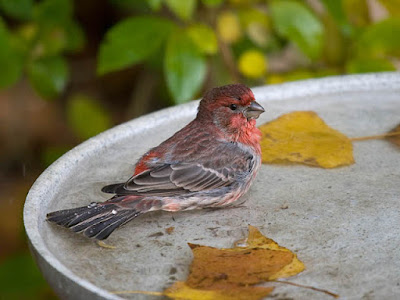 |
| House Finch. Greg Gillson |
Range in Missouri: House Finches are year-round residents throughout Missouri.
Identification: This is a key species for comparing with an unknown bird.
Size: About 6 inches from bill tip to tail tip. Larger than goldfinches and chickadees. Smaller than a White-crowned Sparrows or Spotted/Eastern towhees.
Shape: Medium build with a medium-long notched tail. Round head.
Bill: Short, conical.
Color: Brown and gray above with streaks on the sides of the pale underparts. Males with red (sometimes orange or rarely yellow) crown, chest, rump.
Habitat, range & behavior: You’ll find small flocks on wires, in short treetops and in bushes. Originally deserts and grasslands. Rural areas and towns are where they’re now most common.
Formerly found in the western United States and Mexico. Then introduced into the northeastern United States, but now found in nearly all of the lower-48 states and extreme southern Canada. Rare in plains states (Dakotas to Texas) and southern Florida.
House Finches are not territorial, but males sing throughout the year–a lively, wiry song ending in a couple of buzzy notes.
Food and feeder preference: They love sunflower seeds and tube feeders. May eat from thistle socks.
You may like my in-depth article on attracting House Finches.
19. Black-capped Chickadee (Poecile atricapillus)
This is a common backyard bird in the northern half of the United States.
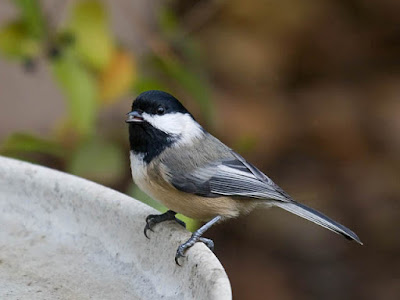 |
| Black-capped Chickadee. Greg Gillson |
Range in Missouri: Black-capped Chickadees are year-round residents in northern Missouri, absent in southern Missouri.
Identification:
Size: Chickadees are small birds, the same general size as an American Goldfinch.
Shape: Round body, big round head, long tail with rounded tip.
Bill: Short, straight, stout.
Color: Gray above, buffy below. Black cap and bib with white lower face. White edges on wing feathers.
Habitat, range & behavior: Deciduous and mixed forests.
They range from the northern half of the United States, southern half of Canada, and most of Alaska.
Small flocks flit actively from tree to tree acrobatically gleaning insects from twig tips. In winter chickadees make up the core of mixed-species flocks also containing nuthatches, kinglets, creepers, woodpeckers and others.
Food and feeder preference: Seeds, insects, berries. They eat at tube, hopper and tray feeders. They love black oil sunflower seeds and suet.
You may like my in-depth article on attracting Black-capped Chickadees.
20. Carolina Chickadee (Poecile carolinensis)
Chickadees are common feeder birds throughout much of North America. This one is common in the southeastern United States.
 |
| Carolina Chickadee. GeorgeB2 from Pixabay |
Range in Missouri: Carolina Chickadees are year-round residents in southern Missouri, absent in northern Missouri.
Identification:
Size: This small bid is the size of an American Goldfinch.
Shape: Round body, round head, longer tail.
Bill: Short, straight, stout.
Color: Gray above. Paler below. Black cap, white face, black bib.
Habitat, range & behavior: Lower elevation deciduous forests, wooded residential areas.
This chickadee is a resident in the southeastern US.
Chickadees cannot chew as sparrows do, so they take one large sunflower seed at a time from your feeder and fly off to a branch to pound it open with their stout bills.
Food and feeder preference: Most of their diet is insects, also seeds. They will eat black oil sunflower seeds from hopper feeders.
21. Northern Flicker (Colaptes auratus)
Of all the bird identification questions I get asked, this common larger backyard bird is the bird most people ask about. It doesn’t occur to those unfamiliar with it that this could be a woodpecker.
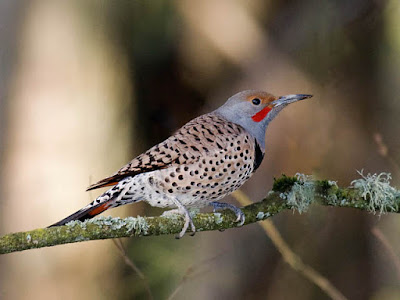 |
| Northern Flicker. Greg Gillson |
Range in Missouri: Northern Flickers are year-round residents throughout Missouri.
Identification:
Size: About the size of a Mourning Dove. Larger than a robin.
Shape: Stocky with short legs, short tail, big head.
Bill: As long as head, thin, slightly curved.
Color: Back is brown with black bars. Under parts pinkish with black spots. Undersides of black wing and tail feathers are bright salmon red (West) or yellow (East). Head gray (West) or brown (East) and males with red (West) or black (East) whisker marks and nape marks (East). Black crescent across chest. White rump seen in flight.
Habitat, range & behavior: Found in woodland edges and forests.
Year-round resident from extreme southern Canada, across all of the lower-48 states and in the mountains of Mexico and Middle America. In summer breeds northward well into Canada and Alaska.
Frequently noted hopping on ground pecking in the ground for insects. In late spring, males proclaim their territory by rapid pounding on a hollow tree branch, though the ringing of metal downspouts at dawn is louder and carries much farther, to the exasperation of anyone trying to sleep inside!
Food and feeder preference: Ants and beetles are their primary foods. Will eat black oil sunflower seeds and are attracted to suet.
22. Common Grackle (Quiscalus quiscula)
Sometimes considered a pest to crops, grackles are longer and lankier than very similar blackbirds.
 |
| Common Grackle. GeorgiaLens. Pixabay |
Range in Missouri: Common Grackles are year-round residents throughout Missouri.
Identification:
Size: Larger than Red-winged Blackbirds, they are near the length of Mourning Doves.
Shape: Long, with long full keel-shaped tail, long legs, flat crown.
Bill: Longer than head, pointed, but stouter than other blackbirds.
Color: Glossy black with hint of bronze or green on head (depending upon population). Yellow eye.
Habitat, range & behavior: They are found in agricultural areas, woodland edges, city parks and lawns.
Resident in the southeastern United States. In summer they migrate northward and west to the central United States and Canada.
They monopolize feeders and are bullies toward other birds.
Food and feeder preference: Grain, corn, acorns, small aquatic fish and amphibians. To discourage them, use tube feeders, rather than hopper or tray feeders. Don’t over-feed, keep spilled seed picked up.
23. Brown-headed Cowbird (Molothrus ater)
Cowbirds are small blackbirds lay their eggs in the nests of other smaller birds, such as warblers. The adoptive parents raise their young!
 |
| Brown-headed Cowbird. Greg Gillson. |
Range in Missouri: Brown-headed Cowbirds are year-round residents throughout most of Missouri, summer residents only in northwestern Missouri.
Identification:
Size: Larger than White-crowned Sparrows, but smaller than Rose-breasted or Black-headed Grosbeaks. Smaller than other blackbirds, starlings, and grackles.
Shape: Perhaps a little bit pot-bellied. Medium length tail. Flat forehead as typical for blackbirds.
Bill: Rather thick and stout.
Color: Males are glossy black with rich brown head. Females are dusty gray-brown throughout. Long-held juvenile plumage similar to pale female, scaly, being fed by Yellow Warbler or Song Sparrow or a hundred other host species.
Habitat, range & behavior: They are found in woodlands and farms. Also, with other blackbirds in winter at shopping center parking lots.
In summer they breed across Canada and most of the United States and Mexico. In winter they move south out of Canada and occupy both coasts and southeastern States in the US.
These small blackbirds join other flocks of blackbirds in cattle feedlots. You may see cowbirds riding on the backs of cattle, sheep, or horses. They originally rode on the backs of American bison on the Great Plains but expanded when forests were cut.
Food and feeder preference: Cowbirds eat grains, seeds, and insects. They will readily come to hopper and platform feeders. They are larger and more aggressive, so keep other birds from feeders and have a big appetite!
24. Indigo Bunting (Passerina cyanea)
Don’t mistake Indigo Buntings for the larger Blue Grosbeak. As the name suggests, the grosbeak has a much larger and thicker bill, along with rusty wing bars, lacking in Indigo Buntings.

Range in Missouri: Indigo Buntings are summer residents throughout Missouri.
Identification:
Size: These birds are a bit smaller than a House Sparrow.
Shape: Plump. Large round head. Medium short tail.
Bill: Large and conical.
Color: Males are deep blue. Females are pale gray-brown with diffuse streaks below.
Habitat, range & behavior: Open woodlands and clearings. Country farm roads.
They are found in the East and parts of the Southwest, north to southern Canada.
Sing from the tallest tip of tree or telephone lines, a cheerful paired bouncy song very similar to American Goldfinch. In fact, they are sometimes called “blue goldfinches” because of this!
Food and feeder preference: These birds will eat seeds from hopper feeders, perhaps more so in the late spring when they first arrive during migration.
25. Song Sparrow (Melospiza melodia)
A common bird, but variable, and similar to many other streaked brown sparrows.
 |
| Song Sparrow. Greg Gillson. |
Range in Missouri: Song Sparrows are year-round residents throughout Missouri.
Identification:
Size: A smaller bird, similar in size to House Finch and juncos. Larger than chickadees and goldfinches. Smaller than White-crowned Sparrows or Spotted/Eastern towhees.
Shape: Plump with round head, long rounded tail.
Bill: Short, conical.
Color: Highly variable in darkness and color saturation across its range (dark rusty to pale gray). Generally gray-brown above with dark brown streaking on back. Complicated head pattern. Streaking on sides and breast converge into dense central breast spot.
Habitat, range & behavior: Thickets, especially near water. Backyard shrubbery.
Resident in western United States, western Canada, coastal southern Alaska, northeastern US. In summer also moves into mid-Canada and northern half of US. In the winter found in most of the US lower-48. Also, a population in central Mexico.
Forages on ground, never far from low cover to which they fly if startled.
Food and feeder preference: Song Sparrows feed on seeds and insects near the ground. Will visit hopper and tray feeders for mixed bird seed.
26. Eastern Phoebe (Sayornis phoebe)
This plain bird is common in backyards in the East.
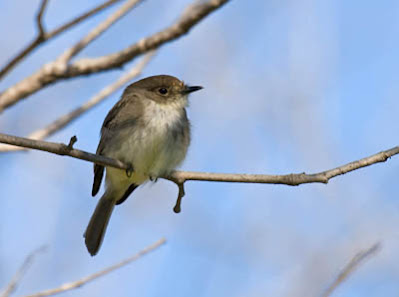 |
| Eastern Phoebe. Greg Gillson. |
Range in Missouri: Eastern Phoebes are summer residents throughout Missouri.
Identification:
Size: About the size of bluebirds. Larger than House Sparrows.
Shape: Rather stout, with long wings, medium-length tail. Pointed but flat bill. Upright posture.
Bill: Black, pointed, wide and flat.
Color: Brownish-gray above, slightly yellow-olive on sides. White under tail coverts. No eye ring or wing bars help distinguish them from some other flycatchers.
Habitat, range & behavior: Found in woodlands, suburbs, farms. Frequently nest in rafters, under eaves, porches.
They are summer residents east of the Rocky Mountains from Canada southward. Year-round residents through the interior of the Southeast, to Texas. Winter visitor to Gulf Coast and southern Atlantic.
Phoebes pump their tail down. They also frequently spread their tails.
Food and feeder preference: They eat flying insects that they catch on the wing. Not a feeder visitor.
27. Barn Swallow (Hirundo rustica)
These swallows are widely distributed throughout the world, primarily breeding in the northern hemisphere, and wintering in the mid-latitudes and southern hemisphere.
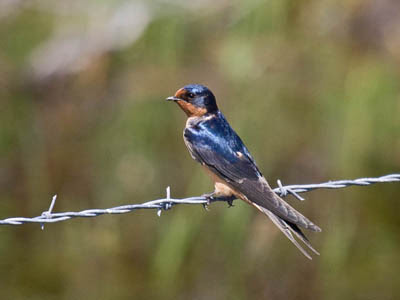 |
| Barn Swallow. Greg Gillson. |
Range in Missouri: Barn Swallows are summer residents throughout Missouri.
Identification:
Size: About the size of a House Finch but with a much longer tail.
Shape: Stocky, short necked but with long body and tail. Tail is forked, with very long outer tail feathers. Wings pointed.
Bill: Short, wide.
Color: Glossy dark purplish-blue above. Pinkish-orange below.
Habitat, range & behavior: Barn Swallows live in open country, frequently near humans. Farmlands. Nest in barns, under small bridges.
In North America breed from Mexico to northern Canada and Alaska, wintering from southern Mexico throughout most of South America.
Frequently seen swooping low over the ground hunting flying insects. Perch on wires, fences. Voice is twitters and chirps with grating sounds.
Food and feeder preference: Eat flying insects on the wing and are not attracted to backyard feeders.
28. Eastern Wood-Pewee (Contopus virens)
Eastern Wood-Pewees and Western Wood-Pewees appear very similar. Their ranges nearly split the continent in half, east and west. Their song separates them; it is a clear whistled pee-a-wee in the Eastern Wood-Pewee, and a burry pee-yeear in the Western Wood-Pewee.
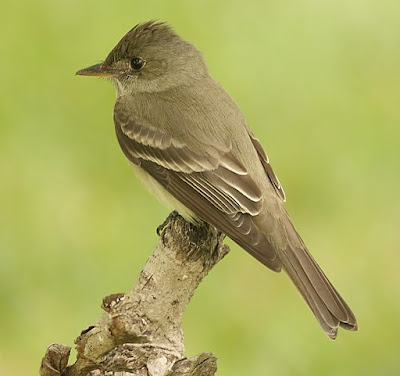 |
| Eastern Wood-Pewee. Tony Castro CC 4.0 |
Range in Missouri: Eastern Wood-Pewees are summer residents throughout Missouri.
Identification:
Size: Bigger than a House Finch; smaller than a bluebird.
Shape: Upright posture. Large head. Thick chest. Long tail. Long wings.
Bill: Medium length, wide at base. Black above; yellow-orange below.
Color: Grayish-olive above, slight yellow tinge below (looks white in strong light). Pale wing bars. No eye ring.
Habitat, range & behavior: Woodlands. Large shade trees in town.
Summer resident in the East, from southern Canada southward.
These flycatchers tend to perch on a dead twig high in the canopy. They sing throughout the day, attracting attention to this otherwise quite drab and nondescript bird.
Food and feeder preference: These birds feed on flying insects and do not come to feeders.
29. Ruby-throated Hummingbird (Archilochus colubris)
This is the only hummingbird that breeds in the eastern half of the United States and Canada.

Range in Missouri: Ruby-throated Hummingbirds are summer residents throughout Missouri.
Identification:
Size: A tiny bird, much smaller than any other in the eastern US, except perhaps some other rare hummingbird.
Shape: The small body is chunky, with a big head, and short tail.
Bill: Very long and tubular, slightly down curved.
Color: Metallic green above, white below with scattered green or gray feathers. Male with glimmering ruby red throat that is black unless it refracts sunlight at just the right angle.
Habitat, range & behavior: They find flowers at forest edges and flower gardens.
They summer in the eastern US and southern Canada, east of the Rocky Mountains. Some winter in from the coast of the Carolinas to Florida and along the Gulf Coast.
Darting flight on a blur of wings that buzz when they flap so fast! They feed by poking their long bill into flowers.
Food and feeder preference: They drink flower nectar from tubular flowers using their long brush-tipped tongue. They also feed on spiders and small flying insects. They are readily attracted to hummingbird feeders filled with sugar water.
30. Eastern Kingbird (Tyrannus tyrannus)
These birds often build nests in trees that overhang streams.
 |
| Eastern Kingbird. Greg Gillson. |
Range in Missouri: Eastern Kingbirds are summer residents throughout Missouri.
Identification:
Size: About the size of a Red-winged Blackbird. Smaller than a robin.
Shape: Fairly sleek. Perches upright with big puffy head, full tail.
Bill: Fairly long, wide at base,
Color: Black head. Black tail with white band at tip. Dark gray upper parts. White under parts.
Habitat, range & behavior: Farms, clearings in woodlands.
Found across Canada and in the United States east from the Rocky Mountains.
These birds perch on fence lines, tips of small trees. Sally out and snatch flying insects and return to perch.
Food and feeder preference: They eat insects and do not come to feeders.
31. Blue-gray Gnatcatcher (Polioptila caerulea)
These small birds creep through the bushes, staying hidden.
 |
| Blue-gray Gnatcatcher. Greg Gillson. |
Range in Missouri: Blue-gray Gnatcatchers are summer residents throughout Missouri.
Identification:
Size: Small bird smaller than House Finch.
Shape: Long tail and long legs. Short neck.
Bill: Short and thin.
Color: Blue gray above, white below. Upper tail black; under tail mostly white.
Habitat, range & behavior: Found in conifer woods and shrubby habitats.
They breed throughout most of the eastern United States and across the southern US. In the winter along the coast from Virginia to California.
They crawl and hop through dense vegetation flipping their long tail about and calling softly.
Food and feeder preference: They eat insects and generally don’t come to feeders.
32. Chipping Sparrow (Spizella passerina)
Chipping Sparrows are a widespread species adapted to human disturbance. They are rather tame. They are frequently found in cemeteries with large trees.
 |
| Chipping Sparrow. Greg Gillson. |
Range in Missouri: Chipping Sparrows are summer residents throughout Missouri.
Identification:
Size: These are small sparrows, bigger than goldfinches or chickadees, but smaller than House Finches or Song Sparrows.
Shape: Plump and fairly long tailed.
Bill: Short and conical.
Color: Striped brown and dark brown above. Grayish under parts. Black line through eye. Crown streaked in winter but in summer becomes solid chestnut. Two white wing bars.
Habitat, range & behavior: Grassy open conifer woodlands with some shrubs, parks, orchards.
Breeds from Alaska, across Canada and south into highlands of Middle America. In winter retreats from northern areas to southern United States and northern Mexico.
In summer solitary or in pairs. In winter they forage in flocks of up to 50 birds.
Food and feeder preference: Weed seeds, supplemented with insects in summer. They may eat black oil sunflower seeds in your feeder, but more likely will feed on mixed seeds on the ground under the feeder.
Common Birds in Missouri
To determine how common each species is I used the data from actual bird sightings from the citizen science program eBird. Birds are listed by frequency. That is, how often the species is recorded on checklists submitted to eBird (a percentage).
When choosing the birds to include in this article I leaned strongly to birds that are present throughout the year in good numbers. Thus, many of the common birds are year-round residents. This means that they live in the same location all year. They raise their young in your neighborhood. They don’t migrate. Or if the species does migrate, the ones living in your area don’t. If this is the case, some migrants may move into your area during certain times of year, adding to the same species that are in your yard full time.
Some migrant birds visit your yard during the “summer.” Often, they arrive in spring and remain until late fall. They nest and raise their young in your neighborhood. These are the summer residents.
Other migrant birds visit your backyard during the “winter.” Some of these winter visitors may arrive in July and remain into April. Others may only be found in the cold of December or January. They key here is that they nest and raise their young somewhere else. They only visit your yard in the non-breeding season.
Migration is an amazing spectacle.
There will be birds that fly through your region in spring or fall (or both). They may visit your backyard only a few days or weeks a year. They aren’t regular enough, or stay long enough, to be included in this article. But the number of briefly visiting migrant birds could double the number of species presented here. You may see them over time. Consult checklists in eBird for your county to see what is possible.
I have generally excluded common waterfowl, birds of prey, shorebirds, seabirds, and others that aren’t usually found in residential areas. But they may certainly fly over or be seen regularly if your home is on a shoreline, for instance.
Most common backyard birds in Missouri throughout the year
The following list is the backyard birds that are, on average, most common throughout the entire year. The list is ordered by most common based on the frequency of how often each species is recorded on checklists submitted to eBird.
- Northern Cardinal (63% frequency)
- Blue Jay (47%)
- Mourning Dove (43%)
- American Robin (43%)
- Red-bellied Woodpecker (42%)
- Tufted Titmouse (41%)
- Downy Woodpecker (39%)
- American Goldfinch (37%)
- American Crow (35%)
- Carolina Wren (33%)
- European Starling (32%)
- White-breasted Nuthatch (27%)
- Dark-eyed Junco (26%)
- Red-winged Blackbird (25%)
- House Sparrow (24%)
- Eastern Bluebird (24%)
- White-throated Sparrow (24%)
- House Finch (23%)
- Black-capped Chickadee (21%)
- Carolina Chickadee (20%)
- Northern Flicker (20%)
- Common Grackle (18%)
- Brown-headed Cowbird (17%)
- Indigo bunting (16%)
- Song Sparrow (15%)
- Eastern Phoebe (15%)
Most common backyard birds in Missouri in winter
- Northern Cardinal (62% frequency)
- Dark-eyed Junco (56%)
- Blue Jay (45%)
- Downy Woodpecker (45%)
- Red-bellied Woodpecker (43%)
- Tufted Titmouse (42%)
- American Goldfinch (36%)
- White-throated Sparrow (36%)
- European Starling (34%)
- Mourning Dove (34%)
- American Crow (34%)
- American Robin (31%)
- White-breasted Nuthatch (30%)
- Carolina Wren (30%)
- House Finch (27%)
- House Sparrow (25%)
- Northern Flicker (24%)
- Black-capped Chickadee (23%)
- Carolina Chickadee (21%)
- Eastern Bluebird (20%)
Most common backyard birds in Missouri in summer
- Northern Cardinal (68% frequency)
- Mourning Dove (56%)
- American Robin (51%)
- Indigo Bunting (46%)
- Blue Jay (42%)
- American Goldfinch (38%)
- Tufted Titmouse (37%)
- Red-winged Blackbird (36%)
- Red-bellied Woodpecker (35%)
- Carolina Wren (34%)
- Barn Swallow (33%)
- Common Grackle (32%)
- Brown-headed Cowbird (31%)
- American Crow (31%)
- Downy Woodpecker (31%)
- Eastern Wood-Pewee (30%)
- European Starling (29%)
- House Sparrow (28%)
- Ruby-throated Hummingbird (28%)
- Eastern Bluebird (26%)
- House Finch (24%)
- Eastern Kingbird (24%)
- White-breasted Nuthatch (24%)
- Eastern Phoebe (22%)
- Blue-gray Gnatcatcher (20%)
- Chipping Sparrow (20%)
Indigo Buntings, Barn Swallows, Eastern Wood-Pewees, Ruby-throated Hummingbirds, and Eastern Kingbirds are found only in the summer.
Dark-eyed Juncos, White-throated Sparrows are found only in the winter.
American Robins and American Goldfinches are found year-round but are much more common in summer than in winter.
Common Backyard Birds of Kansas City, Missouri
 |
| Black-capped Chickadee. Greg Gillson |
- Northern Cardinal (66% frequency)
- American Robin (53%)
- Blue Jay (53%)
- Black-capped Chickadee (50%)
- Red-bellied Woodpecker (43%)
- American Goldfinch (42%)
- Mourning Dove (41%)
- Tufted Titmouse (39%)
- Downy Woodpecker (39%)
- European Starling (37%)
- American Crow (37%)
- House Sparrow (35%)
- Carolina Wren (34%)
- Dark-eyed Junco (31%)
- Eastern Bluebird (25%)
- House Finch (25%)
- White-breasted Nuthatch (23%)
- Northern Flicker (20%)
- White-throated Sparrow (20%)
Black-capped Chickadees and House Sparrows are more common in Kansas City than in the state as a whole.
Otherwise, the backyard birds in Kansas City are very similar to elsewhere in Missouri.
Common Backyard Birds of St Louis, Missouri
- American Robin (72% frequency)
- Northern Cardinal (65%)
- European Starling (65%)
- Mourning Dove (59%)
- Blue Jay (52%)
- Comon Grackle (39%)
- Downy Woodpecker (37%)
- Red-bellied Woodpecker (34%)
- American Goldfinch (32%)
- House Sparrow (32%)
- White-throated Sparrow (32%)
- Northern Flicker (32%)
- Chimney Swift (29%) Learn about this species on eBird
- Red-winged Blackbird (27%)
- White-breasted Nuthatch (24%)
- Tufted Titmouse (23%)
- House Finch (22%)
- Carolina Wren (22%)
- Song Sparrow (22%)
- Carolina Chickadee (21%)
- Dark-eyed Junco (21%)
American Robins are very common in St. Louis. European Starlings, Common Grackles, House Sparrows, White-throated Sparrows, Northern Flickers, and Chimney Swifts are more common in St. Louis than the state average.
Red-bellied Woodpeckers, Tufted Titmice, American Crows, Carolina Wrens are less common in St. Louis than in the state as a whole.
Common Backyard Birds of Springfield, Missouri
- Northern Cardinal (62% frequency)
- American Crow (50%)
- American Robin (47%)
- Carolina Chickadee (46%)
- Blue Jay (43%)
- Tufted Titmouse (42%)
- Mourning Dove (39%)
- American Goldfinch (38%)
- European Starling (37%)
- Downy Woodpecker (36%)
- Red-bellied Woodpecker (36%)
- Carolina Wren (35%)
- Eastern Bluebird (29%)
- House Finch (25%)
- White-throated Sparrow (24%)
- House Sparrow (23%)
- Dark-eyed Junco (22%)
- Common Grackle (20%)
American Crows and Carolina Chickadees are more common in Springfield than the state average.
White-breasted Nuthatches are not as common in Springfield as in the rest of the state as a whole.
Wrapping Up
Missouri has some fabulous backyard birds to see and experience. If you are looking to venture further afield, it also has waterbirds, forest dwellers and raptors.
Water birds:
- Great Blue Heron: Standing tall and regal along rivers and lakes, these large wading birds with long necks and blue-grey plumage often fish for prey.
- Canada Geese: Honking flocks of these large migratory geese are a common sight on waterways, sometimes even taking up residence in parks and urban ponds.
- Wood Ducks: Vibrant and colorful, these dabbling ducks with iridescent plumage frequent freshwater habitats, diving for food and nesting in hollow trees.
Forest dwellers:
- Downy Woodpeckers: These small black and white woodpeckers with a drumming call are common sights in wooded areas, searching for insects under bark.
- Pileated Woodpeckers: Larger and louder than their downy cousins, these impressive birds with red crests create impressive holes in trees, searching for insects and sap.
- Eastern Bluebirds: Dazzling bluebirds with rusty orange chests add a pop of color to wooded edges and open fields. They are cavity nesters and readily use bluebird houses.
Birds of prey:
- Red-tailed Hawk: These soaring raptors with broad wings and rusty-red tails patrol the skies, scanning for prey like rodents and small birds.
- American Kestrel: Smaller and more agile than their hawk cousins, kestrels hover in mid-air before diving down to catch insects and lizards.
- Eastern Screech-Owl: These camouflaged owls with piercing eyes and ear tufts hunt small mammals and insects at night, often heard near wooded areas.
Places to go birding in Missouri:
- Mark Twain National Forest: Diverse habitats offering opportunities to see everything from warblers to woodpeckers and raptors.
- Mingo National Wildlife Refuge: Wetlands and marshes attract water birds like ducks, geese, and herons, while upland areas host grassland species.
- Powell Wildlife Refuge: Known for its large population of bald eagles, this refuge also boasts a variety of waterfowl and other birds.
- Lake of the Ozarks State Park: A popular resort area with diverse habitats, offering good opportunities for spotting bald eagles, osprey, and many other species.
Frequently Asked Questions
What is the state bird of Missouri?
Missouri’s state bird is the Eastern Bluebird! This delightful songbird with its bright blue plumage, cheerful song, and beneficial insect-eating habits has held the title since 1927.

The eastern bluebird is a fitting symbol for Missouri due to its:
- Commonness: It is found throughout the state in open woodlands, fields, and parks, making it readily observed by residents and visitors alike.
- Symbolism of happiness: These beautiful birds are often associated with good luck and hope, bringing a joyful element to the natural landscape.
- Beneficial behavior: Their diet primarily consists of insects, including pesky ones like beetles and grasshoppers, making them valuable for pest control.
Many Missourians even take efforts to attract eastern bluebirds to their properties by installing bluebird houses. These nesting boxes provide safe havens for the birds to raise their young, contributing to their conservation efforts.
What are the small gray birds in Missouri?
Tufted Titmice are common residents in Missouri, so you have a good chance of finding them in various locations throughout the state. Here are some tips to increase your chances:

Habitats:
- Woodlands: They prefer deciduous and mixed forests with mature trees, offering them plenty of food and nesting cavities. Look for them in parks, nature reserves, and wooded areas along rivers and streams.
- Backyards: If you have mature trees in your backyard with natural cavities or nest boxes, tufted titmice might readily visit your feeders and explore the area.
- Open areas with scattered trees: They occasionally venture into fields and meadows with scattered trees or hedgerows, especially where they can find insects and fruits.
Food Sources:
- Bird feeders: Offer a variety of seeds, sunflower hearts, nyjer, and suet cakes. They readily use feeders placed in sheltered locations away from squirrels and other predators.
- Natural food sources: They forage for insects, nuts, fruits, and berries. Look for them inspecting tree bark, gleaning berries from shrubs, or cracking open nuts.
Tips for spotting:
- Listen for their song: They have a clear, whistled “peter-peter-peter” call, which is often their first giveaway.
- Look for their movement: They are active and acrobatic birds, flitting amongst branches and hanging upside down to reach food.
- Observe their crest: Their namesake crest of feathers on their heads stands out, especially when they raise it in alarm or excitement.
What is the smallest bird in Missouri?
Determining the absolute “smallest” bird in Missouri involves considering different approaches:
By weight: The ruby-throated hummingbird takes the crown for the tiniest Missouri resident, weighing around 3-5 grams, just about the weight of a nickel! They are incredibly delicate and rely on constant feeding of sugary nectar from flowers.
By length: For length, the blue-gray gnatcatcher wins with a mere 4.7 inches from beak to tail. These tiny marvels flit amongst treetops, catching insects and singing high-pitched songs.
By overall size: Considering both weight and length, the ruby-throated hummingbird again emerges as the champion of mini dimensions in Missouri.
_______________________________________________________________________________________________
Related Articles:
Feeding winter birds in Missouri.
Red, Orange, & Yellow birds of Missouri
34 of the most common birds in the United States (with photos)











We just moved to the SW corner of Missouri from Central Kansas. There are birds here I’m not familiar with. This has been very helpful in identifying them! Thank you.
I'm so glad you found this useful. I put a lot of hard work into it and it is nice to know it is appreciated. Thank you.
Thank you. During this pandemic I am enjoying my backyard as never before. Your knowledge has helped me further enjoy my backyard. Thank you.
I'm with you. I'm going stir-crazy. I'm so glad I have a change of scenery with the birds right outside my window. Thanks for saying hi.
Can you identify a tiny dull with light breast bird? Building a nest in a gourd on the front porch. Pretty, twittery song, straight longish beak, slight brown when feathers against the sun. Always seems to be in bright sun or dark shadow. I live in Excelsior Springs.
Thanks for visiting, RHammer!
Yes, I think your bird is a Carolina Wren. They nest in cavities. The bill description is very helpful. Well done!
To verify, it is bird #11 in this article with a description and photo. Is that it?
I have a beautiful & diverse ecosystem in my yard. I cannot find 4 of the bird species that I can't identify listed here. One set I am interested in has mated & produced their 3rd batch of your ones.
How great to have such a wonderful yard! I hope you figure out all the birds that are still mysteries to you! That's the great thing about bird watching, I think–the challenge of the unknown and the new discoveries.
Thank you so much for this! I apparently had a Blue jay and Red-bellied woodpecker in my backyard eating dry cat food I had out there for a stray cat! By the way, is dry cat food harmful for those two birds? Again, thanks for this very helpful article!
No, nothing wrong with dry cat food for birds. Not surprised the jay ate it. I wouldn't have guessed that it wood be liked by woodpeckers, though!
Thanks for sharing your observation!
Thank you for this well put-together article! My family recently moved to (eastern) Missouri from over the Rockies and since buying a house abutting a small forested area with a stream, I've seen many birds I don't recognize. I've checked out an identification guide from the library a couple times and tried to wade through all the birds, but eventually gave up or just ran out of time.
This morning a Northern Flicker Woodpecker (of the East variety, I know this thanks to you) landed in my yard within clear view of my back door and proceeded to pick at a spot in my yard for a good ten minutes. After some quick research I learned the correct terms (like 'malar stripe' and 'nape') to hone my internet searches. When I put 'backyard' as a search term, your site popped up and it is exactly what I have been looking for! Thank you for sharing your knowledge with us all and making backyard birding more accessible!
Thank you Kassie for your kind words!
Thank you for this list of birds I still can’t figure out about the chickadee or the finches I am unclear which ones they are when are the finches I know but I can’t tell if the chickadees or sparrows
Chickadees are little tiny balls of fluff with long tails hanging acrobatically to feed. The finches or house sparrows are ore stout and hop on the ground in large flocks.
Those birds are so beautiful. Their photos are taken by you or you refer to another source.
Thank you so much for this comprehensive list – I love all of your pictures! I am contemplating a move from the inland valleys is San Diego County to the St. Louis area and, as a bird enthusiast here, was curious what I might find there. I have bookmarked your site and hope to be using it enthusiastically in the not-to-distant future. Thank you again.
Glad it was useful!